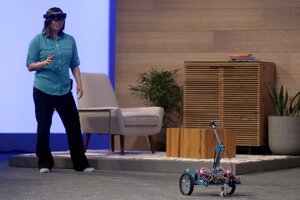BUILD 2015 conference: 4 things to know about Microsoft’s HoloLens
Microsoft shared more details about the HoloLens, its head-mounted augmented-reality device, at the 2015 BUILD developer conference. Reviewers say the HoloLens is capable of making virtual objects seem as real as the physical ones that surround us.

Microsoft's HoloLens will have a separate holographic processing unit and the ability to map objects and sounds in three-dimensional space. Here, a woman uses HoloLens to control a robot at the 2015 BUILD conference in San Francisco on April 29, 2015.
Jeff Chiu/AP
Microsoft announced HoloLens, its 3D augmented-reality headset, back in January at the company’s Windows 10 update event. Reviewers who got to try on prototype models said the addition of holographic images on top of a user’s physical surroundings was utterly convincing. But details about HoloLens have been a little thin – including, importantly, how exactly the headset works.
At the company’s 2015 BUILD conference for developers, Microsoft explained how developers would build 3D apps for the HoloLens – and in the process, shared some details on how the headset will actually function in practice. Here are four things to know about the Microsoft HoloLens:
1. It will be fully self-contained
The HoloLens prototypes that Microsoft allowed journalists to review in January were unfinished. They had wires protruding from the headset itself, and many of the electronics were contained in a pack that draped around the user’s neck. Now that Microsoft has had a chance to refine the unit’s design, the HoloLens consists only of a pair of goggles with a band encircling the user’s head. All the electronics, including a battery and a small computer running the Windows 10 operating system, are self-contained.
2. It uses voice and gesture control
The main way of physically interacting with the objects shown by HoloLens is by tapping them with your finger and thumb, a gesture Microsoft refers to as Air Tap. HoloLens doesn’t yet support more complex interactions such as those you’d perform in front of a game console running Kinect, but it might as the software matures. The HoloLens does support voice commands, so you can tell it to perform certain actions on the holographic images it’s generating – speaking as you would to Apple's Siri or Microsoft's Cortana mobile-phone virtual assistants – and it will comply.
3. It has spatial mapping and sound
One of the main advantages of an augmented-reality headset such as the HoloLens is the feeling of interacting with virtual objects and spaces: it can convincingly create new surroundings in a way that a TV or computer monitor can’t. One key to that is spatial mapping, the technique by which HoloLens observes everything in the user’s surroundings, including walls and furniture, and notes where the boundaries are so that its projections can appear to interact with those physical objects. The HoloLens is also capable of spatial sound, making audio louder as the user moves toward its apparent source, or generating sounds for the interaction of physical and virtual objects.
4. It has a separate hologram processing unit
In a followup blog post, Microsoft noted that the HoloLens has a central processing unit (CPU) and graphics processing unit (GPU), just like a regular computer, as well as a separate processor to track the user’s surroundings and head movements. This third unit, referred to as a Holographic Processing Unit (HPU), frees up the HoloLens’s other computing resources to run developer apps.
Microsoft still hasn’t announced when the HoloLens will be available, or how much it will cost. But early reviews of the headset are exceedingly positive, and between the HoloLens and related virtual-reality units such as the Oculus Rift or Valve's HTC Vive, it appears that the notion of head-mounted computing may finally catch on for good.

